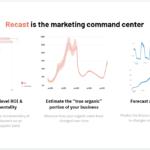With the rise of e-commerce over the last 15 years many brands came to rely on digital tracking methodologies (sometimes called “attribution” or “MTA” models) in order to measure the effectiveness of their marketing campaigns. While this form of measurement is incredibly valuable in some situations, it has many limitations which marketers and executives need to be aware of before they rely on this type of measurement for all of their decision-making.
The main flaws of digital tracking are:
- Doesn’t measure true incrementality
- Biased towards more bottom-of-funnel channels
- Can’t be used to measure offline channels
- Works differently for different types of channels (not apples-to-apples)
- Doesn’t work well for multi-device or cross-device purchase journeys
- It only works for owned digital distribution channels
It’s important that marketers understand all of these limitations when they’re interpreting results from their digital tracking platform.
In the rest of this blog post we’ll first talk about how digital tracking works and then work through each of these points of limitation and explain why it matters and how it impacts your reports.
How does digital tracking work?
The idea behind digital tracking is simple: track people across the internet and see what ads they see or click on prior to purchasing. For every customer in your database you could (in theory) see all of the ads they engaged with prior to purchase. Then, you can attribute that customer or that purchase to one or multiple of the touchpoints the customer engaged with prior to purchase.
The most famous algorithm for assigning credit among tracked touchpoints is the so-called “last-touch attribution” which just means assigning credit for the conversion to the last ad a user engaged with prior to purchase. There are many other algorithms that one could potentially use including first-touch attribution (assign credit to the first touchpoint) or varieties of multi-touch attribution (assign a blend of credit among the different touchpoints).
While this sounds great in theory, in practice we cannot actually track all of the relevant touchpoints. For example, if a user isn’t “logged in” we generally can’t track them across devices. So if they click on an ad on their phone and then later go back to the website on their desktop computer or tablet to make a purchase, we often can’t connect those events and so we’re missing part of the true purchase journey.
Additionally, advertising properties that get views and not clicks are generally even more difficult to track. To the extent that a view of a Youtube ad doesn’t generate a click but does generate a purchase (i.e., if they open a new tab to search after seeing the ad) then we would be missing very important touch points when we go to determine credit for the purchase.
Limitations of Digital Tracking
So while digital tracking can be a powerful tool, it has many limitations when it comes to using the results of digital tracking for making strategic marketing decisions.
Digital tracking doesn’t measure true incrementality
The most important limitation of digital tracking is that it doesn’t measure true incrementality. Incrementality (the causal relationship between marketing activity and business performance) is the thing marketers actually care about for optimizing budgets, and digital tracking is not set up to measure incrementality.
Digital tracking is an associative measure that tells you if someone engaged with a digital ad prior to purchase, but not if that ad caused them to purchase. We are always left with the lingering doubt about whether that customer would have purchased anyway even if not for the ad.
In general, the bigger your brand is and the more different marketing channels you’re active on, the further your digital tracking measurement is going to be from true incrementality.
Biased towards more bottom-of-funnel channels
Digital tracking methodology tends to be more biased towards the most bottom-of-funnel channels because those channels tend to be the easiest channels to track since they tend to result in clicks. Digital search type channels like Google tend to 1) happen late in the buyer’s journey very close in time to the purchase and 2) result in clicks not just impressions.
More upper-funnel channels or channels that primarily drive impressions as opposed to clicks (YouTube, Streaming TV, Display, etc.) often get under-credited because they are more difficult to explicitly track and due to the way they’re consumed it’s often less likely that they generate a click even if they do impact the purchase decision.
Can’t be used to measure offline channels
Offline channels like television, radio, and out of home pose real significant problems in any digital tracking methodology because it’s impossible to know which individuals received an impression and there’s obviously know way to track a direct click in the medium itself.
While some brands might use things like coupon codes or vanity URLs to attempt to track the impact of these ads, the ability to track is definitely less robust when compared to other digital channels. This introduces bias in the measurement method that marketers must be aware of when interpreting the results.
Works differently for different types of channels (not apples-to-apples)
All of the above means that the read you get from the digital tracking methodology is not the same across your channels. The read you get for Facebook or for search is not apples-to-apples with the read you get from an offline channel or a channel that is known to generate fewer clicks. This makes accurate decision-making off of these measurements very difficult since you can’t really compare the results across different types of channels.
Doesn’t work well for multi-device or cross-device purchase journeys
The tracking is only as good as our ability to actually track users across their whole journey. If a user is watching a series via a connected TV and then searches for a brand on their phone after seeing an advertisement, it can be very difficult to make the connection between those two different “users” and changes to privacy regulations are making that increasingly difficult.
If you’re not able to actually see the whole journey for a user, then all bets are off when it comes to making decisions using this methodology.
It only works for owned digital distribution channels
Digital tracking only works when you own the point of conversion. If your brand sells a lot through non-owned digital channels like Amazon or other online retailers or through brick-and-mortar or offline retailers, then digital tracking won’t be able to tell you anything about how your marketing is impacting those channels. If someone watches a YouTube ad and then searches for your product on Amazon, digital tracking will not be able to tell you anything about the relationship between the ad and the eventual conversion.
Conclusion
Digital tracking is a powerful tool for digital marketers and it definitely has its uses, especially for real-time monitoring of performance of campaigns within a certain marketing channel. However, there are many limitations associated with digital tracking and it’s critical for marketers to understand these limitations when interpreting the results and using them for decision making and optimization.


